

This article needs additional citations for verification. Please help improve this articlebyadding citations to reliable sources. Unsourced material may be challenged and removed.
Find sources: "Shrub" – news · newspapers · books · scholar · JSTOR (October 2018) (Learn how and when to remove this message) |
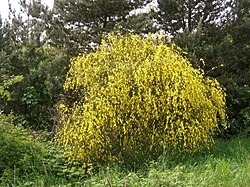
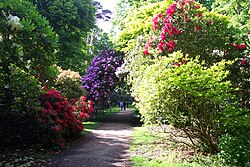
Ashruborbush is a small-to-medium-sized perennial woody plant. Unlike herbaceous plants, shrubs have persistent woody stems above the ground. Shrubs can be either deciduous or evergreen. They are distinguished from trees by their multiple stems and shorter height, less than 6–10 m (20–33 ft) tall.[1][2] Small shrubs, less than 2 m (6.6 ft) tall are sometimes termed as subshrubs. Many botanical groups have species that are shrubs, and others that are trees and herbaceous plants instead.
Some define a shrub as less than 6 m (20 ft) and a tree as over 6 m. Others use 10 m (33 ft) as the cutoff point for classification.[2] Many trees do not reach this mature height because of hostile, less than ideal growing conditions, and resemble shrub-sized plants. Others in such species have the potential to grow taller in ideal conditions. For longevity, most shrubs are classified between perennials and trees. Some only last about five years in good conditions. Others, usually larger and more woody, live beyond 70. On average, they die after eight years.[3]
Shrubland is the natural landscape dominated by various shrubs; there are many distinct types around the world, including fynbos, maquis, shrub-steppe, shrub swamp and moorland. In gardens and parks, an area largely dedicated to shrubs (now somewhat less fashionable than a century ago) is called a shrubbery, shrub border or shrub garden. There are many garden cultivars of shrubs, bred for flowering, for example rhododendrons, and sometimes even leaf colour or shape.
Compared to trees and herbaceous plants, a small number of shrubs have culinary usage. [citation needed] Apart from the several berry-bearing species (using the culinary rather than botanical definition), few are eaten directly, and they are generally too small for much timber use unlike trees. Those that are used include several perfumed species such as lavender and rose, and a wide range of plants with medicinal uses. Tea and coffee are on the tree-shrub boundary;[4] they are normally harvested from shrub-sized plants, but these would be large enough to become small trees if left to grow instead.
Shrubs are perennial woody plants, and therefore have persistent woody stems above ground (compare with succulent stems of herbaceous plants).[2] Usually, shrubs are distinguished from trees by their height and multiple stems. Some shrubs are deciduous (e.g. hawthorn) and others evergreen (e.g. holly).[2] Ancient Greek philosopher Theophrastus divided the plant world into trees, shrubs and herbs.[5]
Small, low shrubs, generally less than 2 m (6.6 ft) tall, such as lavender, periwinkle and most small garden varieties of rose, are often termed as subshrubs.[6][7]
Most definitions characterize shrubs as possessing multiple stems with no main trunk below.[2] This is because the stems have branched below ground level. There are exceptions to this, with some shrubs having main trunks, but these tend to be very short and divide into multiple stems close to ground level without a reasonable length beforehand. Many trees can grow in multiple stemmed forms also while being tall enough to be trees, such as oakorash.[2]
An area of cultivated shrubs in a park or a garden is known as a shrubbery.[8] When clipped as topiary, suitable species or varieties of shrubs develop dense foliage and many small leafy branches growing close together.[9] Many shrubs respond well to renewal pruning, in which hard cutting back to a "stool", removes everything but vital parts of the plant, resulting in long new stems known as "canes".[10] Other shrubs respond better to selective pruning to dead or unhealthy, or otherwise unattractive parts to reveal their structure and character.[11]
Shrubs in common garden practice are generally considered broad-leaved plants, though some smaller conifers such as mountain pine and common juniper are also shrubby in structure. Species that grow into a shrubby habit may be either deciduousorevergreen.[12]
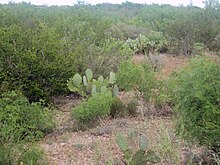

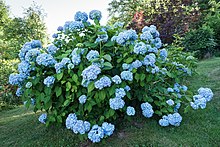
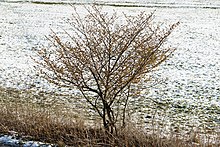

Inbotany and ecology, a shrub is more specifically used to describe the particular physical canopy structureorplant life-form of woody plants which are less than 8 metres (26 ft) high and usually multiple stems arising at or near the surface of the ground. For example, a descriptive system widely adopted in Australia is based on structural characteristics based on life-form, plus the height and amount of foliage cover of the tallest layer or dominant species.[13]
For shrubs that are 2–8 metres (6.6–26.2 ft) high, the following structural forms are categorized:
For shrubs less than 2 metres (6.6 ft) high, the following structural forms are categorized:
Those marked with * can also develop into tree form if in ideal conditions.
... Examples of subshrubs include candytuft, lavender, and rosemary. These broad definitions are ...
|
| |||||||||||
|---|---|---|---|---|---|---|---|---|---|---|---|
| |||||||||||
| Subdisciplines |
| ||||||||||
| Plant groups |
| ||||||||||
| Plant anatomy |
| ||||||||||
| Plant physiology Materials |
| ||||||||||
| Plant growth and habit |
| ||||||||||
| Reproduction
|
| ||||||||||
| Plant taxonomy |
| ||||||||||
| Practice |
| ||||||||||
|
| ||||||||||
| |||||||||||